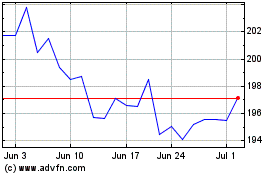UPDATE: CME Cuts Back Expanded Hours Proposal; 21-Hour Day Could Start June 4
May 17 2012 - 2:27PM
Dow Jones News
CME Group Inc. (CME) said Thursday it is now seeking to expand
grains futures trading to 21 hours per day, rather than 22 hours,
in response to concerns from grain industry groups.
CME's announcement comes a day after it withdrew its proposal to
the Commodity Futures Trading Commission to expand to a 22-hour
day. That plan had been set to take effect Monday, but had drawn
criticism from some traders, brokerage firms and grain elevator
operators.
Under the new plan, trading of corn, wheat and soybean futures
will be halted for three hours each day, from 3 p.m. to 6 p.m. ET.
The prior plan included only a two-hour break, from 5 p.m. to 7
p.m.
"We're working with the CFTC to implement these new hours as
soon as possible," CME spokesman Chris Grams said. The exchange
seeks to implement that plan no later than June 4, Grams said.
In addition to its new proposal to expand trading to 21 hours,
up from 17, CME filed a separate request with the CFTC Thursday
asking them to expedite the request. If approved, the expanded
hours could begin as soon as Monday's trading day. The CFTC
typically requires a waiting period of 10 business days before
exchanges can enact changes to trading hours.
A statement from CME on the new plan included support from the
National Grain and Feed Association, a large industry group that
had called for a 30-day delay before expanded hours began.
"This action by the CME Group demonstrates the value of
collaboration between the exchange and users of futures and options
markets who rely heavily on the [Chicago Board of Trade] contracts
to hedge marketplace risk," NGFA acting president Randall Gordon
said.
The NGFA had voiced concern about CME's original plan, saying
the two-hour break did not give grain merchants enough time to
reconcile their trading accounts and "perform other required
accounting and back-office operations" without adding to staffing
costs.
The new plan doesn't address another criticism of expanded
trading hours: that the market would be trading immediately
following monthly government crop reports. Critics have said that
allowing trade immediately after the report will make for highly
volatile markets and put some traders at a disadvantage.
CME's current schedule halts trading each day from 8:15 a.m. ET
until 10:30 a.m., and again from 2:15 p.m. until 7 p.m.
The U.S. Agriculture Department currently releases its monthly
supply and demand reports at 8:30 a.m. ET.
Despite its support for the CME's revised plan, the NGFA remains
concerned about the timing of USDA reports, spokesman Todd Kemp
said. The NGFA has received a "strong commitment" from CME that it
will continue to look for ways to address the issue, Kemp said,
adding that his group hopes the IntercontinentalExchange Inc.
(ICE), which launched its own grain futures on a 22-hour trading
schedule this month, "joins the conversation."
"Ideally the reports would be released when both markets are
closed," Kemp said.
-By Ian Berry, Dow Jones Newswires; 312-750-4072;
ian.berry@dowjones.com
CME (NASDAQ:CME)
Historical Stock Chart
From Mar 2024 to Apr 2024

CME (NASDAQ:CME)
Historical Stock Chart
From Apr 2023 to Apr 2024
